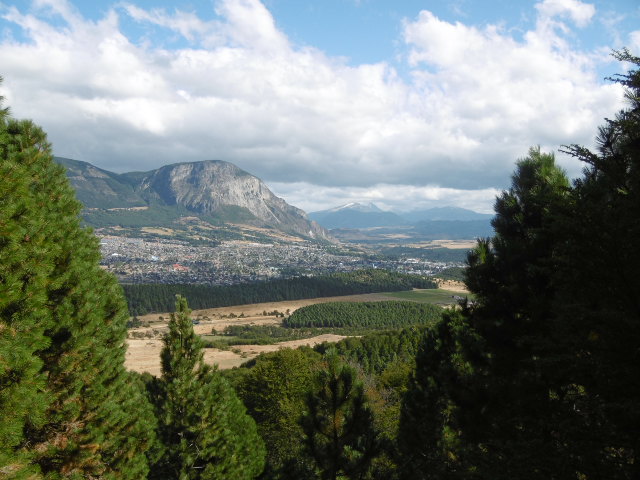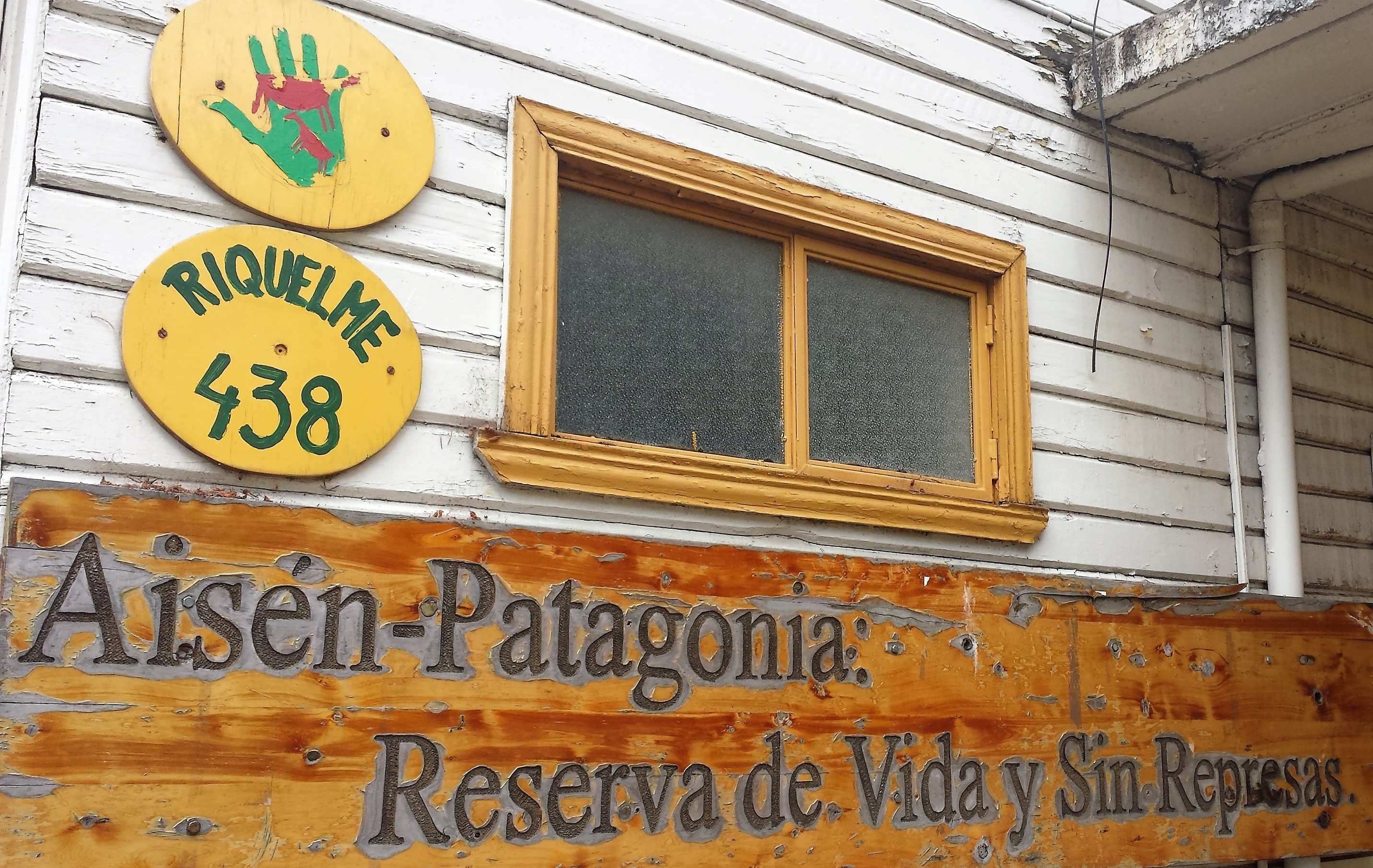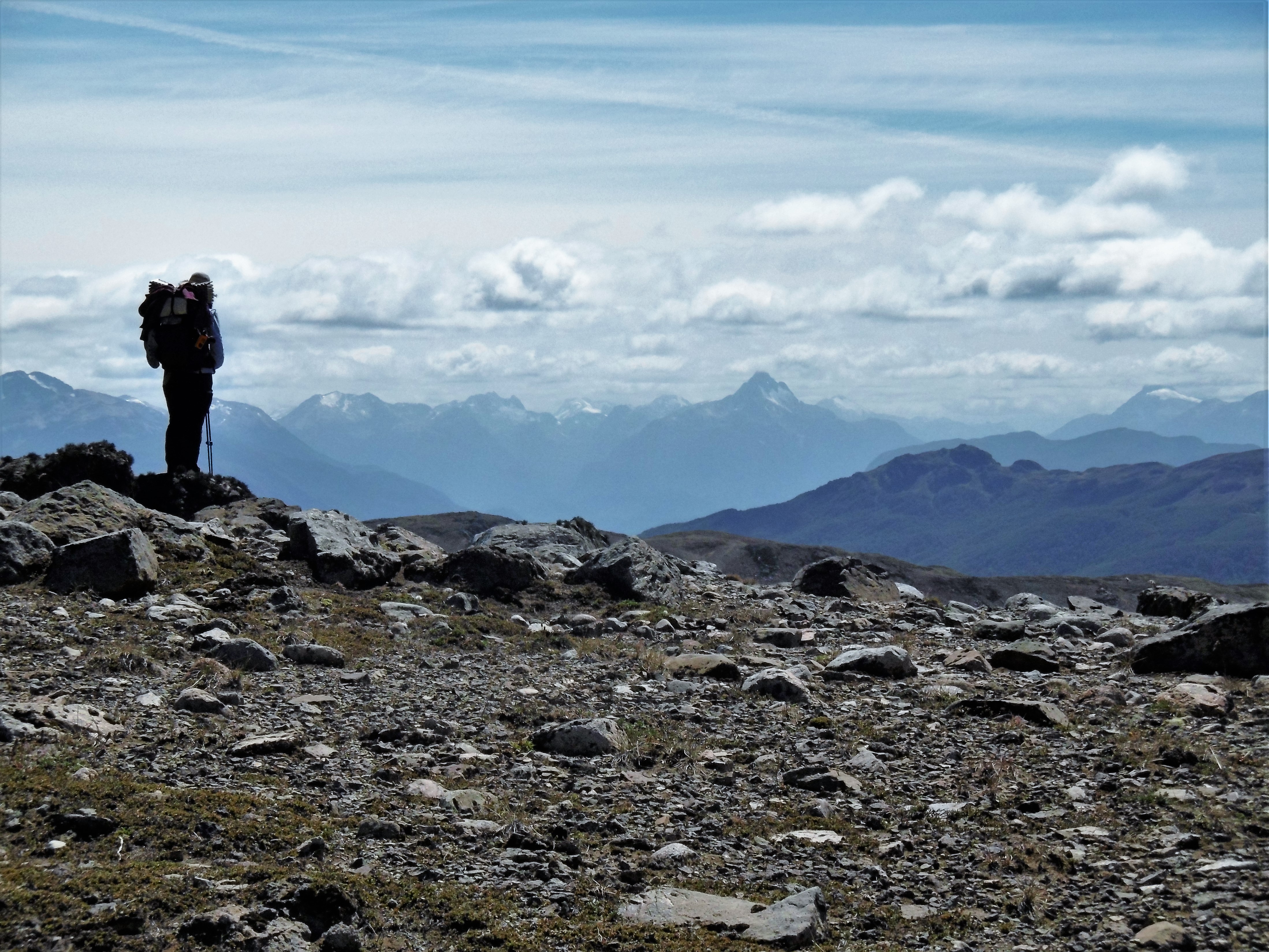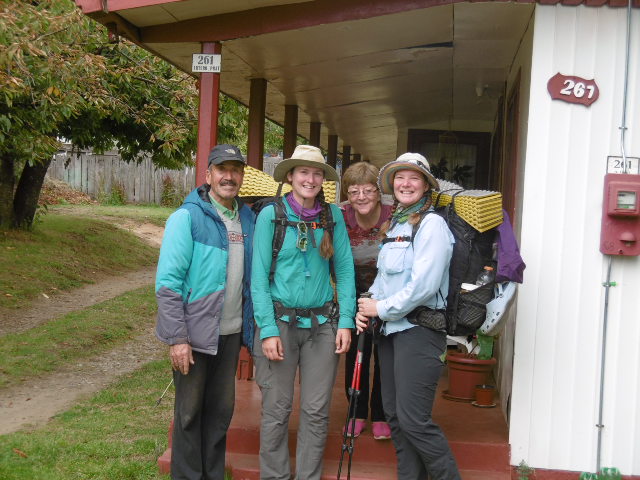Haz clic aquí para leer en español
At the time of writing this, it is mid-March and running chainsaws seems to be a countryside pastime throughout Patagonia. From the folks I’ve talked to along the way, they made their appearance around 30 years ago and have been humming away ever since. Almost every person we’ve met so far owns at least one.
We know humans are near when mid-morning chimes chainsaw thirty. Then hammer crap o’clock happens until siesta and mate. The roadwalk into and out from Coyhaique, the regional capital of Aysén, was no exception.

Walking into the city marked a shift from the secluded south. Power lines and paved roads. I bought an empanada from a young person who is trans and saw an openly gay couple in the biggest supermarket yet. It had an entire aisle of mayonnaise. In the plaza de armas a women’s chainsaw art convention buzzed for days.

This was also where I got to touch base with Patagonia Sin Represas. An organization whose life-blood flows according to the interest of the people. This seemed to be a quiet period as the lone guardian, Peter, shared the information and resources which had been produced on the waterways, most of them from the crux of the HidroAysén Showdown.

Peter was the lone man holding down the fort. His eyes truly came to light when we began speaking of adventures. He rummaged under the piles of papers on his desk and began checking the margins of a desk calendar and named off a few other intrepid adventurers who have passed through the area in past years.
We ended up taking a week to rest and catch up on writing and business, well cared for and comfortable in the home of friends. Again, friends now inextricably entwined in our hearts and lives. Friends we only had yet to meet. Friends who live and love deeply and represent their beliefs at every turn.

As we move north, conversing with folks both in the towns and the countryside, everyone agrees, things are changing. Two interesting initiatives I’ve noted in both Argentina and Chile are art installations and public WiFi in the town squares of even the remote villas and pueblos. There is no guarantee as to the quality of the connection, but it is there.
Everyone has a cell phone and prefer broadband to backwaters. We witness the ever widening gap between the “old ways” and the “future.” Most of those who still live in the remote countryside through which we hike are aging. Some hold out, others seek to sell their ranch land to give the money to their adult children, on whom they will rely in retirement.

For some, it is unquestioning, “yes, I see this progress as good,” Moises tells us. We sit in the small one-bedroom country home on the land where he was born. As with most of the places we’ve encountered, the bathroom is an outhouse. Here, unlike most of what we have seen until now, he has running electricity. In the tradition of Patagonian hospitality, he insisted on putting us up for the night. We stay in his quincho, a large building centered around a brick pit where they roast lamb for an asado.
The next morning he walks us up into the foothills behind his house. We push to keep up with his quick stride for some time before he quietly admits he was the running champion of his village for 5 years straight in his younger days.

He points the mountain route to the next town, Manihuales. We followed up old logging roads, passing stacks of old, now rotting, wood and large fulcrumed trunks, signs of a time before heavy machinery.
At a vaguely alluded to juncture, Neon’s instincts prickled and we caught the lightly used footpath which wound up to a most beautiful alpine meadow at the base of a rocky ridge. We ate lunch, enjoyed the blue skies, and assessed the approach before heading up to that space between land and sky – an austere environment where only a few hardy shrubs and lichens survive.

Along the ridge and down into the next valley, trail-less through groping trees (which stole 1 glove). Until, seeing signs of ancient tree cuts, we stumbled upon a bridge and and an abandoned logging road. This led to a still-used logging road, which fed out to a fence line, which led to an actual dirt road.
Stepping into the village, onto the paved road (always a weird feeling), albeit the back way, we saw equal measures of those traveling on horse and by car. A few blocks further we stumbled out onto the Carretera Austral.
The next day, Moises met us in town, at the hospidaje (a sort of hostel, the closest thing to an affordable hotel in these small towns) run by his son and wife. Here, only last year did they form an association to promote tourism to the village.

From there it was a day and a half roadwalk to Villa La Tapera. While I dislike roadwalks, this was the only viable legal route.
Ciudades y aldeas de la región de Aysén
Traducción por Henry Tovar
En el momento de escribir esto, es mediado de marzo y poner en marcha moto sierras parece ser un pasatiempo campesino en la Patagonia. De la gente con las que he hablado en el camino, hicieron su aparición hace alrededor de 30 años y han estado tarareando distancia desde entonces. Casi todas las personas que hemos conocido hasta ahora son propietarias de al menos una.
Sabemos que los seres humanos están cerca cuando las campanadas de las moto sierras suenan a media mañana. A continuación, el martillo de la mañana en punto pasa hasta la siesta y el mate. El senderismo dentro y fuera de Coyhaique, la capital de la región de Aysén, no fue una excepción.

Caminar a la ciudad marcó un cambio desde el sur aislado. Las líneas eléctricas y carreteras pavimentadas. Compré una empanada de una persona joven que es trans y vi una pareja homosexual en el supermercado más grande aún. Tenía un pasillo entero de mayonesa. En la plaza de armas de convecciones del arte de moto sierra de la mujer sonó durante días.

Este fue también el lugar donde llegué a tocar la base con la Patagonia sin represas. Una organización cuya sangre vital fluye de acuerdo con el interés de la gente. Esto parece ser un período de silencio como el guardián solitario, Peter, compartió la información y los recursos que se habían producido en los cursos de agua, la mayoría de ellos desde el punto crucial del arreglo de cuentas de HidroAysén.

Pedro fue el único hombre que sostiene el fuerte. Sus ojos realmente salieron a la luz cuando comenzamos a hablar de las aventuras. Se revolvió bajo las pilas de papeles en su escritorio y comenzó a comprobar los márgenes de un candelario de escritorio y el nombre de algunos otros intrépidos aventureros que han pasado por la zona en últimos años.
Terminamos tomando una semana para descansar y ponerse al día sobre una escritura y de negocios, bien cuidado y cómodo en la casa de unos amigos. Una vez más, amigos ahora inextricablemente entrelazados en nuestros corazones y vidas. Amigos que sólo acabamos de conocer, amigos que viven y aman profundamente y representan sus creencias en cada vuelta.

A medida que avanzamos hacia el norte, conversando con la gente, tanto en las ciudades como en el campo, todo el mundo está de acuerdo, las cosas están cambiando. Dos iniciativas interesantes que he notado en Argentina y Chile son instalaciones de arte y wifi pública en las plazas de los pueblos, incluso en las villas y pueblos remotos. No hay ninguna garantía en cuanto a la calidad de la conexión, pero está ahí.
Todo el mundo tiene un teléfono celular y prefieren banda ancha a remansos. Somos testigos de la brecha cada vez mayor entre las “viejas formas” y el “futuro”. La mayoría de los que todavía viven en el campo remoto al cual vamos de excursión están envejeciendo. Algunos aguantan, otros tratan de vender sus tierras, ranchos, para dar el dinero a sus hijos adultos, en los que se basarán su jubilación.

Para algunos, es incuestionable. “si, veo este progreso tan bueno”, Moisés nos dice. Nos sentamos en la pequeña casa de campo de un dormitorio en la tierra que lo vio nacer. Al igual que con la mayoría de los lugares que hemos encontrado, el baño es un retrete. Aquí, a diferencia de la mayor parte de lo que hemos visto hasta ahora, hay electricidad. En la tradición de la hospitalidad Patagónica, insistió en que nos situáramos para pasar la noche, nos quedamos en su quincho, un gran edificio en torno a un pozo de ladrillos donde se asan cordero para el asado.
A la mañana siguiente caminamos hasta las faldas detrás de su casa. Empujamos para mantenernos al día con su paso rápido durante algún tiempo antes de que él en voz baja admitiera que corrió campeón de su pueblo por 5 años consecutivos en su juventud.

Señala la ruta de montaña a la siguiente ciudad, Mañihuales. Dimos seguimiento a los viejos caminos forestales, pasando pilas viejas, ahora en descomposición, maderas y troncos grandes, signos de un tiempo antes de la maquinaria pesada.
En una vagamente aludida coyuntura, los instintos de neon picaban y cogimos el sendero ligeramente usado, que terminó en una hermosa pradera alpina en la base de una cresta rocosa. Tomamos el almuerzo, disfrutamos de los cielos azules, y evaluamos la aproximación antes de la partida hasta ese espacio entre la tierra y el cielo. Un ambiente austero donde sólo pocos arbustos resistentes sobreviven.

A lo largo de la cresta y hacia abajo en el valle siguiente, menos camino a tientas a través de árboles (que robaron 1 guante). Hasta que, viendo señales de cortes de árboles antiguos, nos topamos con un puente y un camino de saca y abandonado. Esto nos llevó a un camino de extracción utilizado todavía, que alimentaba a una línea de la cerca, lo que llevó a un camino real de tierra.
Al entrar en el pueblo, en la carretera pavimentada (siempre una sensación extraña), aunque el camino de vuelta, vimos medidas iguales de los que viajan a caballo y en coche. Unas cuadras más nos tropezamos hacia afuera sobre la carretera Austral.
Al día siguiente, Moisés nos recibió en la ciudad, en el hospedaje (una especie de albergue, lo más parecido a un hotel asequible en estos pequeños pueblos) dirigido por su hijo y su esposa. Aquí, sólo el año pasado hizo que formaran una asociación para promover el turismo en el pueblo.

A partir de ahí fue un día y medio caminando por la carretera a Villa la Tapera. Si bien no me gusta caminar por la carretera, esta era la único camino viable legal.






Comments (1)
Very nice post, pictures are great too!
Be safe,
Bill